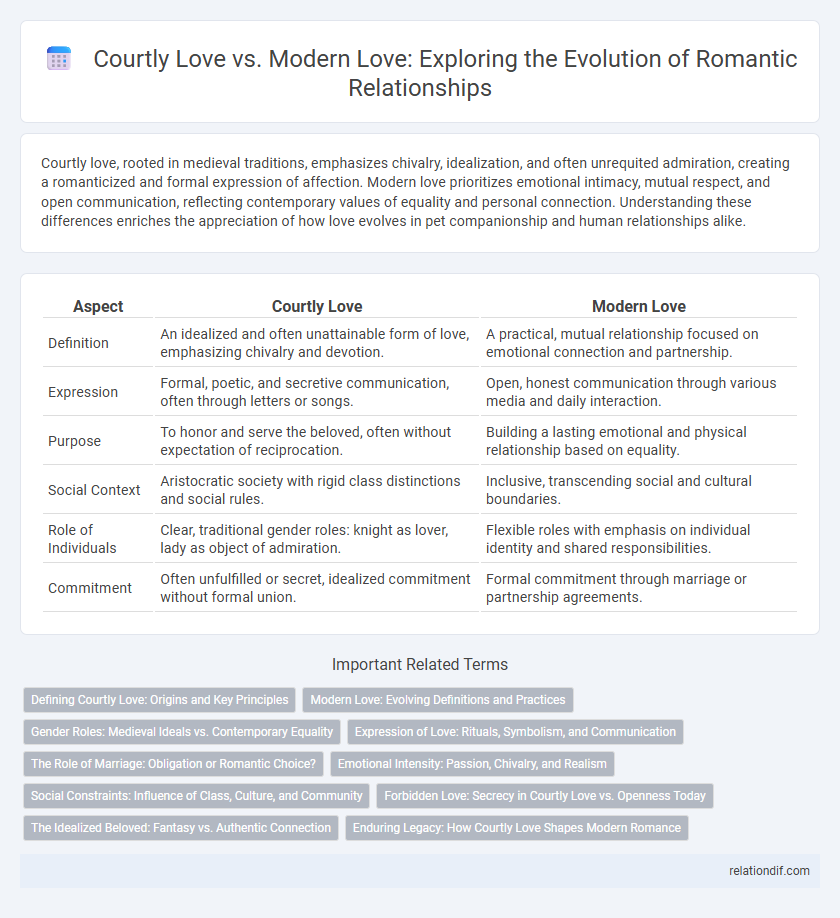Courtly love, rooted in medieval traditions, emphasizes chivalry, idealization, and often unrequited admiration, creating a romanticized and formal expression of affection. Modern love prioritizes emotional intimacy, mutual respect, and open communication, reflecting contemporary values of equality and personal connection. Understanding these differences enriches the appreciation of how love evolves in pet companionship and human relationships alike.
Table of Comparison
| Aspect | Courtly Love | Modern Love |
|---|---|---|
| Definition | An idealized and often unattainable form of love, emphasizing chivalry and devotion. | A practical, mutual relationship focused on emotional connection and partnership. |
| Expression | Formal, poetic, and secretive communication, often through letters or songs. | Open, honest communication through various media and daily interaction. |
| Purpose | To honor and serve the beloved, often without expectation of reciprocation. | Building a lasting emotional and physical relationship based on equality. |
| Social Context | Aristocratic society with rigid class distinctions and social rules. | Inclusive, transcending social and cultural boundaries. |
| Role of Individuals | Clear, traditional gender roles: knight as lover, lady as object of admiration. | Flexible roles with emphasis on individual identity and shared responsibilities. |
| Commitment | Often unfulfilled or secret, idealized commitment without formal union. | Formal commitment through marriage or partnership agreements. |
Defining Courtly Love: Origins and Key Principles
Courtly Love originated in the medieval European courts during the 12th century, characterized by chivalry, idealization, and secret admiration between nobility. Its key principles emphasize unattainable affection, noble gestures, and the ennobling power of love that transcends social boundaries. Unlike modern love, Courtly Love often involved ritualized expressions of devotion without physical consummation.
Modern Love: Evolving Definitions and Practices
Modern love redefines intimacy by prioritizing emotional authenticity, mutual respect, and individual growth over rigid societal roles that characterized courtly love. Unlike the idealized and often unattainable devotion in medieval courtly love, contemporary relationships emphasize communication, consent, and diversity in expressions of affection. This evolution reflects broader cultural shifts toward inclusivity, digital connectivity, and evolving gender norms.
Gender Roles: Medieval Ideals vs. Contemporary Equality
Courtly love emphasized rigid medieval gender roles, portraying men as noble knights devoted to idealizing and serving passive, virtuous women. Modern love challenges these traditional dynamics by promoting gender equality, encouraging mutual respect, emotional openness, and partnership between individuals regardless of gender. Contemporary relationships prioritize shared decision-making and reject hierarchical roles, reflecting broader societal shifts toward inclusivity and egalitarianism.
Expression of Love: Rituals, Symbolism, and Communication
Courtly love emphasized formalized rituals and symbolic gestures such as secret messages, poetic declarations, and chivalric acts to communicate affection within strict social codes. Modern love embraces diverse forms of expression, leveraging open communication, digital messaging, and personalized symbols to convey emotional intimacy. Both paradigms reflect cultural values in the ways love is ritualized, symbolized, and articulated between individuals.
The Role of Marriage: Obligation or Romantic Choice?
Courtly love often portrayed marriage as a social obligation, distinct from the romantic admiration expressed in secret or idealized forms. Modern love emphasizes marriage as a romantic choice founded on mutual affection, compatibility, and personal fulfillment. This shift reflects broader cultural changes valuing individual desire over social duty in relationships.
Emotional Intensity: Passion, Chivalry, and Realism
Courtly love emphasized idealized passion and chivalric devotion, often marked by unattainable longing and ritualized expressions of admiration. Modern love prioritizes emotional realism and mutual vulnerability, balancing intense passion with authentic connection and practical intimacy. The shift from idealized pursuit to genuine partnership reflects evolving cultural attitudes toward romance and emotional expression.
Social Constraints: Influence of Class, Culture, and Community
Courtly love emerged within rigid medieval social hierarchies, where class distinctions and cultural codes strictly dictated romantic expression and behaviors, often idealizing unattainable relationships within noble circles. Modern love, influenced by evolving social norms and greater cultural diversity, embraces individual choice and emotional authenticity, reducing the impact of class and community pressures on romantic relationships. Both forms reveal how social constraints shape love's expression, but contemporary society increasingly values personal agency over traditional class and communal expectations.
Forbidden Love: Secrecy in Courtly Love vs. Openness Today
Courtly Love thrived on secrecy and coded communication, with lovers often concealing their feelings to maintain honor and social boundaries, creating a sense of forbidden allure. In contrast, modern love embraces openness and transparency, valuing honest emotional expression and public acknowledgment even in relationships once considered taboo. This shift reflects changing societal norms around privacy, trust, and the acceptance of diverse love forms.
The Idealized Beloved: Fantasy vs. Authentic Connection
Courtly love idealizes the beloved as a distant, almost unattainable figure, fostering a fantasy rooted in admiration and longing rather than reality. Modern love emphasizes authentic connection, prioritizing emotional intimacy, mutual understanding, and real-life compatibility over idealized perceptions. This shift reflects cultural changes toward valuing genuine, reciprocal relationships instead of purely romanticized fantasies.
Enduring Legacy: How Courtly Love Shapes Modern Romance
Courtly love, a medieval tradition characterized by chivalry and idealized devotion, profoundly influences modern romance through its emphasis on emotional depth and respectful admiration. The enduring legacy of courtly love manifests in contemporary expressions of love that value commitment, poetic gestures, and mutual respect between partners. Modern love, while more diverse and egalitarian, continues to draw on these foundational ideals, blending historical romantic codes with present-day values.
Courtly Love vs Modern Love Infographic

 relationdif.com
relationdif.com